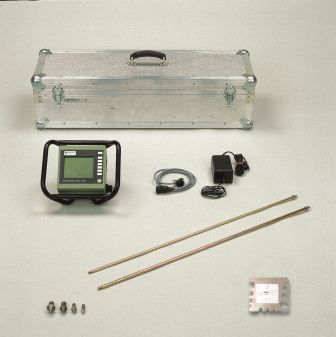

Why is it important to monitor soil compaction?

September 24, 2014
If you grow crops knowing the compaction of your soil is important to ensure crop yields are maximised and water and soil quality is not degraded due to increased run-off and soil structure destruction.
The continuous consolidation and emergence of the ‘super farms’ means that herds are growing, more forage is harvested per farm, more manure is being produced, larger equipment is used to spread manure and harvest and transport crops and grain, and the opportunity to tailor field operations to optimum soil conditions for traffic is decreasing. Compaction is therefore an issue that will likely increase in importance in the future.
There are two forms of compaction: surface and subsurface. While surface compaction can be partly alleviated with normal tillage operations, subsurface compaction below the normal tillage depth can remain. Fracturing or cutting subsurface compacted soil has, in some cases, resulted in remarkable yield increases. Many farmers suspect they have a subsurface compaction problem, but have no knowledge as to how to measure it. A tool to measure the extent and depth of subsurface compaction is a penetrometer. Van Walt supplies several types including:
Hand penetrometer – a compact, low maintenance, easy to operate hand penetrometer available in two sets for probing to depths between 1 and 3 metres. Both sets contain a measuring instrument, probing rod and cones. The soil resistance is measured by a cone and is read from a pressure gauge.
Penetrologger – an easy to use, lightweight fully electronic data logger for storage and processing of 500 measurements with 1mm accuracy over a penetration depth of 80cm. Depth is measured by ultrasound and pre-programming of a field project can be done in advance of going out in the field and with built in, highly accurate GPS will help you find site locations again and again. Data is presented graphically or numerically for further data processing and our penetrologger is fitted with an adjustable LCD screen which is completely splash/waterproof.
Penetrograph – a mechanical, scientific instrument for the determination of the penetration resistance of the ground with a graph drawn on weather-proof plasticised paper which can be re-used to show trends. With continuous measurement up to 80cm the penetrograph is ideal for measuring disturbed layers and the effectiveness of compaction on different soils.
Penetrometer for Top Layers – a handheld penetrometer for top layers. Ideal for shallow measurements and horizontal measurements in, for example, profile pits. Supplied with measuring device, extension rods, sounding rods, various cones, compression spring and tools.
Pocket Penetrometer – designed to determine the penetration resistance of top layers and of samples in the field and the laboratory with a measuring range 0.5 MPa. And immediate readout of the penetration resistance is given.
The same basic principle is at the heart of each of our penetrometers. A penetrometer is designed to mimic a plant root. Of course a plant root is living and much smaller than a penetrometer but in studies conducted at the United States Department of Agriculture’s Agriculture Research Service (USDA-ARS), root penetration into soil cores packed to different densities were measured and compared to penetrometer readings. Root growth decreases linearly with increasing penetration resistance, until practically stopping above 300 psi. Remember, however, that roots may still penetrate soil with a penetration resistance greater than 300 psi if natural cracks and pores are present.
Much of this research was done with growing cotton, but it also appears to hold true for other crops. Although the limit of zero root growth may not be exactly at 300 psi, it is certain that root growth will be greatly inhibited at higher penetrometer readings. This is true in both wet and dry soils and is independent of soil texture.
The readings taken with a penetrometer are called the cone index. For best results, readings should be taken approximately 24 hours after good rainfall so the best time of the year for compaction testing is in the spring because the whole profile has usually been thoroughly moistened during the winter. If the soil is too wet (muddy), compaction could be underestimated because the soil acts as a liquid. If the soil is too dry, compaction could be overestimated because roots will be able to penetrate the soil when it dampens. The idea behind using the penetrometer at field capacity is that this is the best-case scenario for roots. Hopefully, the soil will be at field capacity at various times during the growing season. During these periods, roots will be able to penetrate soil that has low penetration resistance. Penetration resistance will increase when the soil dries out, and root growth can then be expected to be limited. However, when the moisture content of the soil increases again, penetration resistance will decrease, and root growth will resume.
Spring is also the start of the traditional growing season – what better time to monitor your soil conditions?
To find out more call Van Walt Ltd on +44 (0)1428 661 660.
You might also be interested in...
Van Walt Guidelines for sampling for PFAS in Groundwater
November 13, 2024We need to make clear, that at the time of writing, there are no ISO or EN standards which deal with the sampling of groundwater for PFAS.
Read MoreSpot measurement v. continuous environmental monitoring
August 25, 2023Environmental monitoring has developed considerably over the years. From the time when a consultant went out monthly or quarterly with a dip tape to monitor the groundwater level in a borehole, wind forward...
Read MoreMeasuring Nitrates (NO3, NO3-N) in the field
June 20, 2023The interest in Nitrates is nothing new. One way or another we have been measuring them for half a century.
Read MoreVan Walt Environmental Equipment
A small selection of our environmental equipment